5 Yoga Tips for a More Comfortable Hero Pose
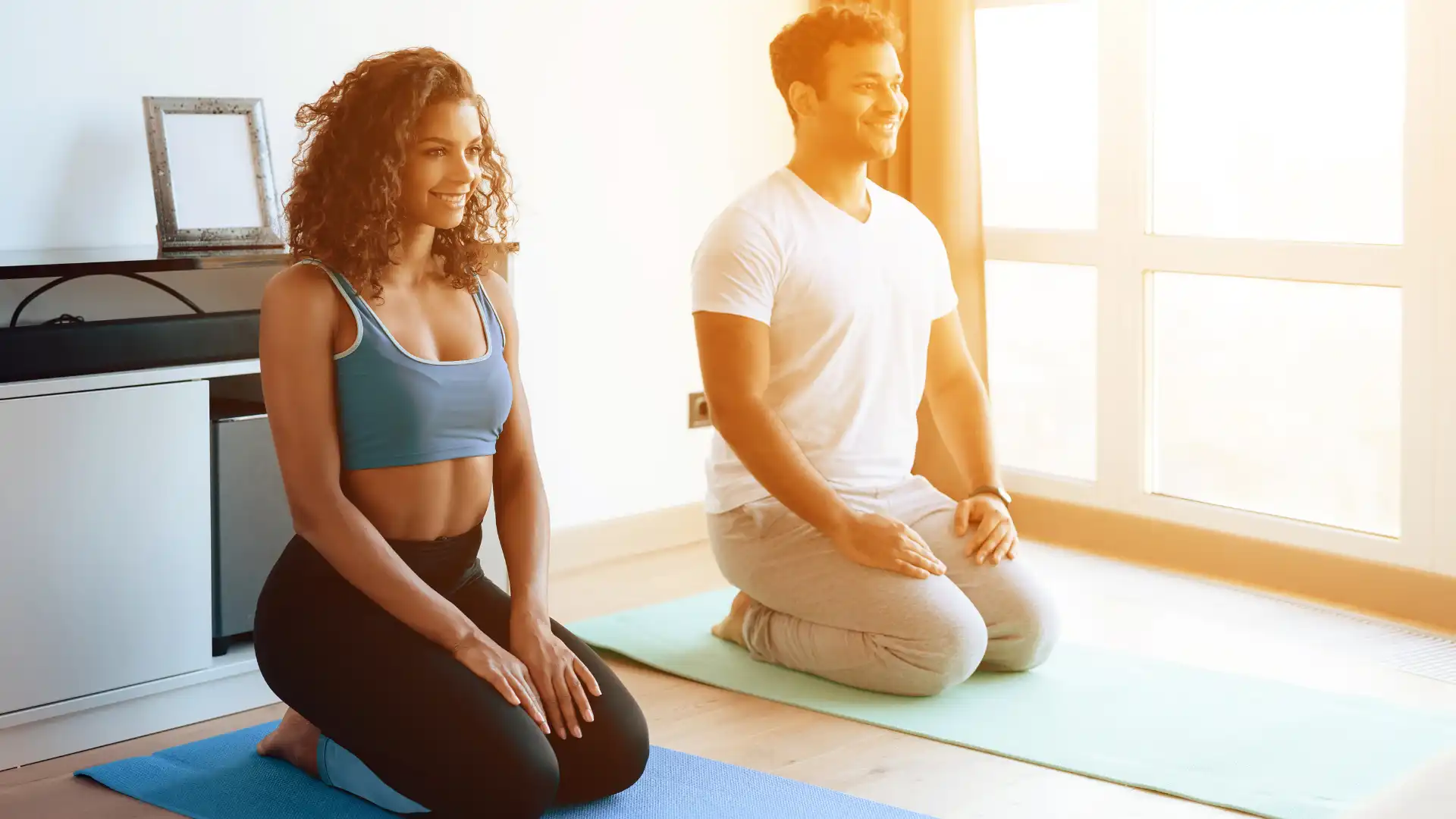
Virasana (Hero Pose) can serve as an alternative pose for those who can’t sit in Sukhnasana (Easy Sitting Pose) for long periods of time. However, in Hero Pose, the challenges for your body are different than they are for Easy Sitting Pose (Sukasana). Anatomical variations that affect your ability to get comfortable in this pose include the level of flexibility in your knee joints, ankle joints, lower spine, front thigh muscles, and even the tops of your feet. However, in general, the five recommendations below for propping and practicing the pose will allow you to sit in Hero Pose comfortably, even if you are stiff in one or more of those areas.
Caution: As with any pose, please come out of this one if you experience pain or anxiety while practicing it. Then try the pose again with different propping. If you simply cannot get comfortable in Hero Pose no matter what you do, practice another pose instead. For long seated sessions, you may find that switching between Hero Pose and Easy Sitting Pose can be helpful. And, of course, sitting on a chair for seated meditation or breathing practices is always a good alternative.
1. Pad Your Shins and Support Your Pelvis
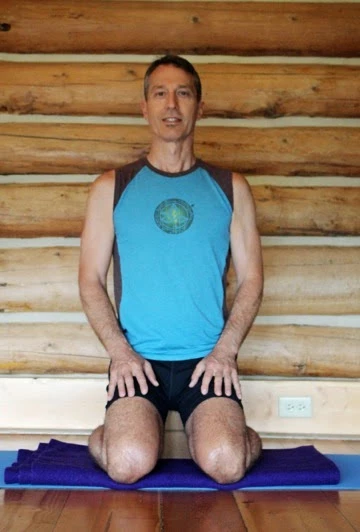
Using padding under your shins makes your knees, shins, and feet more comfortable in the pose (no bones pressing right into the floor!).
Having support under your pelvis is beneficial for those who are less flexible in the knee joints, front thigh muscles, lower spine, and ankle joints. Sitting on a prop allows the pelvis to tilt slightly forward so your lower spine can take its natural curve. This creates a healthier seated position than if your lower back is rounded.
Baxter, who is somewhat less flexible in the knees and fronts of his thighs, always sits on at least one block on its lowest or middle or lower height. But everyone is different, so we suspect you will need to experiment to discover the height that is best for you. And in general, if you feel pain in the pose, you should try again with a higher prop.
- To come into the pose, start by placing a folded blanket on your mat that’s large enough to support your knees and shins. Then kneel on the blanket, with your knees near the front of the blanket, and your ankles and feet hanging off the back edge. Have your knees hips-distance apart, but splay your shins a bit wider apart in back.
- Then place a block on its lowest or middle height, or a stack of two blocks, sideways between your feet, so both sitting bones can rest on it. If you want to sit very high on a cushy surface, try sitting on the end of a bolster. Then carefully sit back on the prop. Adjust your pelvis, as you might move it in Marjaryasana/Bitilasana (Cat/Cow Pose), until your lower back feels like it has a nice natural arch.
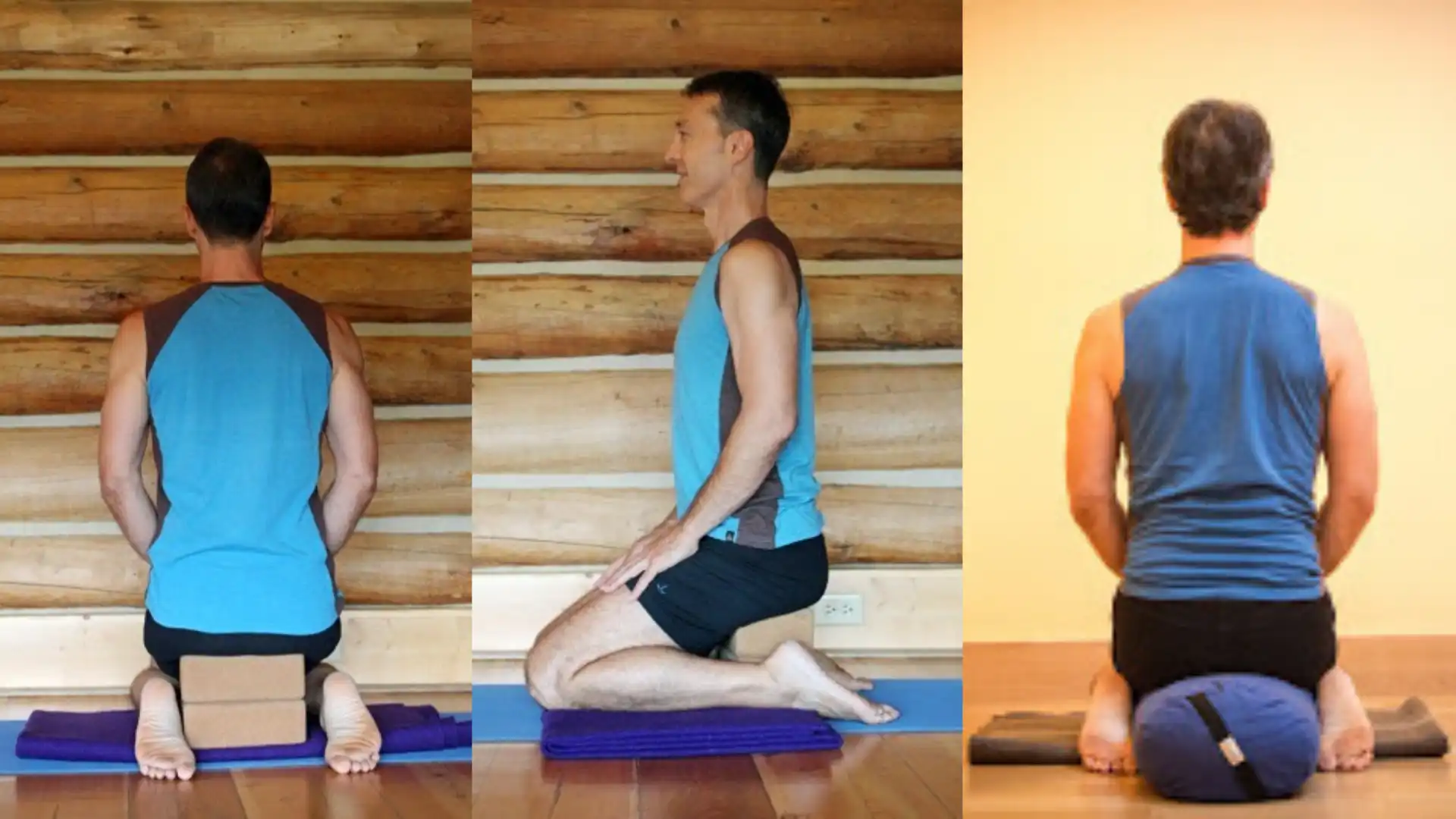
(back view and side view of Hero Pose using blocks and using a bolster.)
2. Support Your Ankles
Some practitioners have stiff, inflexible ankles. So if your ankles are uncomfortable even with the props shown above, you can use a blanket roll under your ankles to relieve that tension. To improve ankle flexibility in the long run, practice poses such as Balasana (Child’s Pose) and Bhujangasana (Cobra Pose) that stretch your ankles and the tops of your feet. But be aware that the range of motion in everyone’s ankles is different, so it could be that you will be happier using props whenever you sit in Hero Pose.
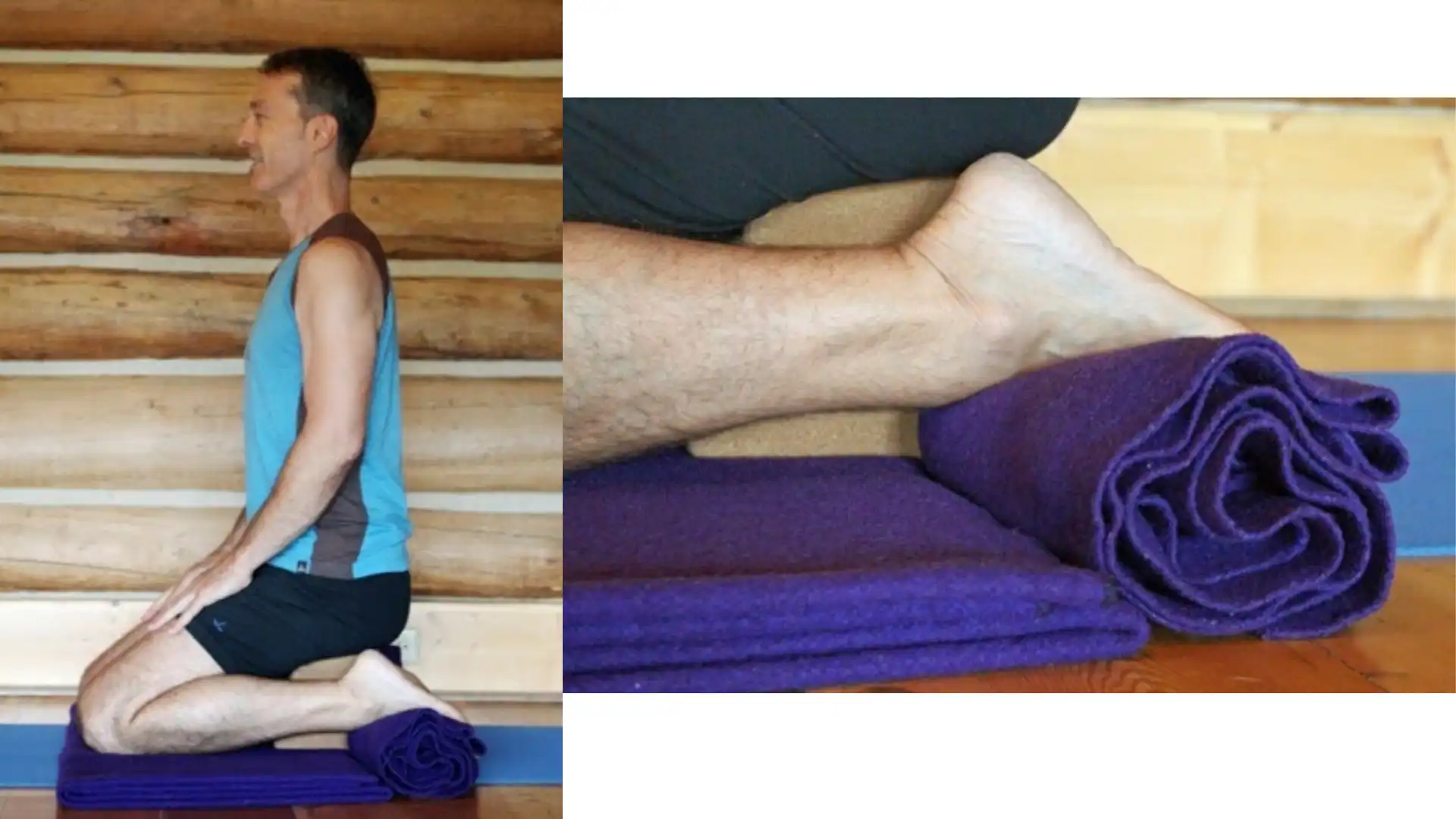
3. Support Your Feet
If the tops of your feet are tight and the blanket roll doesn’t work for you (it makes things worse for Nina!), you can sit on a stack of blankets (2, 3, or even more) and let your feet hang off the back edge.
- To come into the pose, place the prop you’ll be sitting on near the back edge of the blanket stack.
- Next kneel on the blanket stack with your ankles at the very back edge of the blanket, on either side of the prop, and your feet hanging off.
- Then lower yourself onto the prop with your ankles on the stack but your feet hanging off.
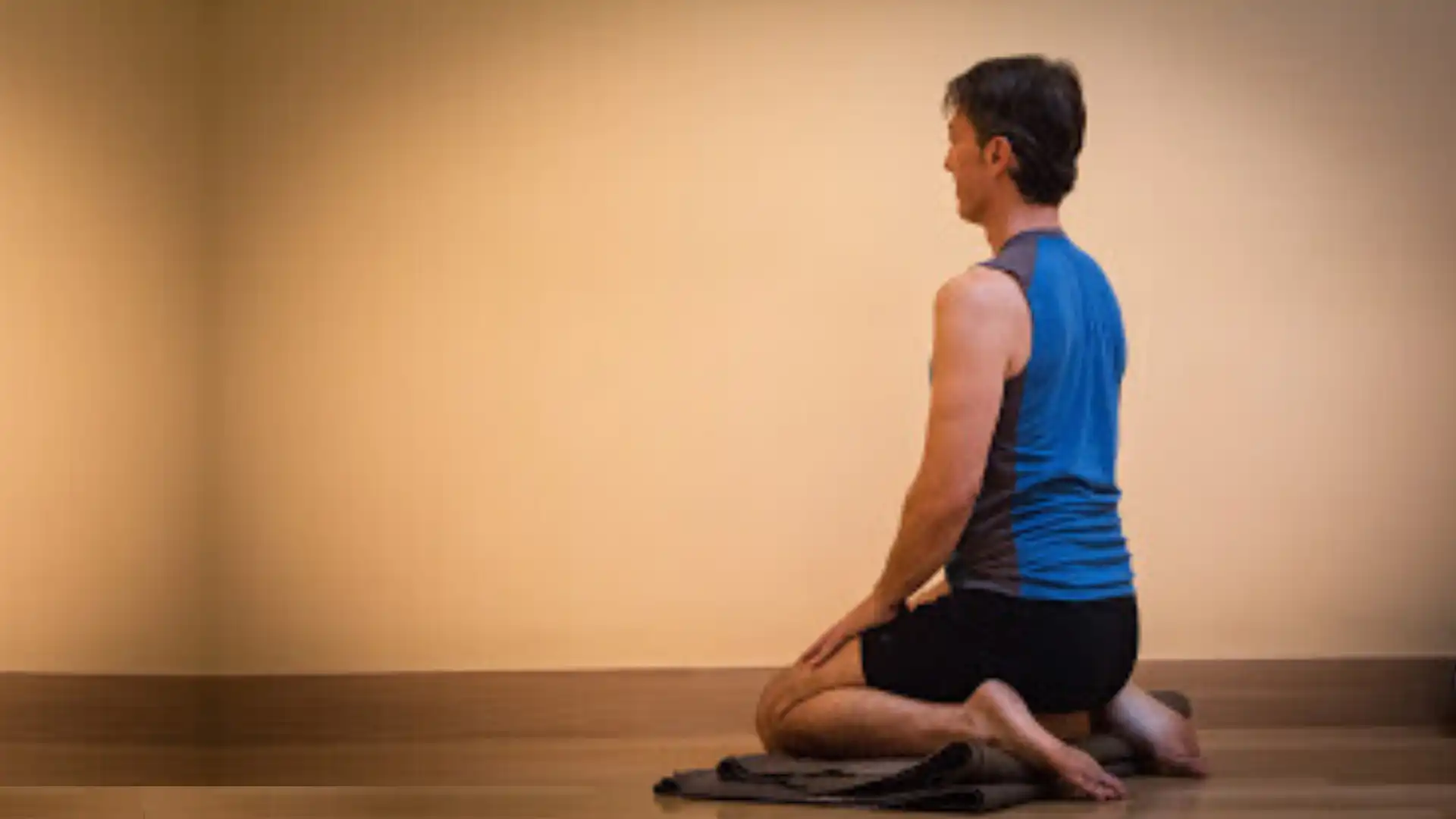
4. Create Your Inner Lift
An important way to keep your body happy in this pose is to stay focused and active as you practice it, rather than just sagging in the pose. To do this, as you continue to sit, focus on lengthening the center of your spine up from your sitting bones through the crown of your head.
Notice how long you can maintain this feeling of inner lift before you begin to sag and lose support. Then, try to re-establish the movement again for a while. If you start to tire and can no longer easily maintain your inner lift, stop for the day, and note how long you sat. Gradually experiment with spending more time in your seated position, so that eventually you will be ready to sit for longer periods of time.
5. Come Out Carefully
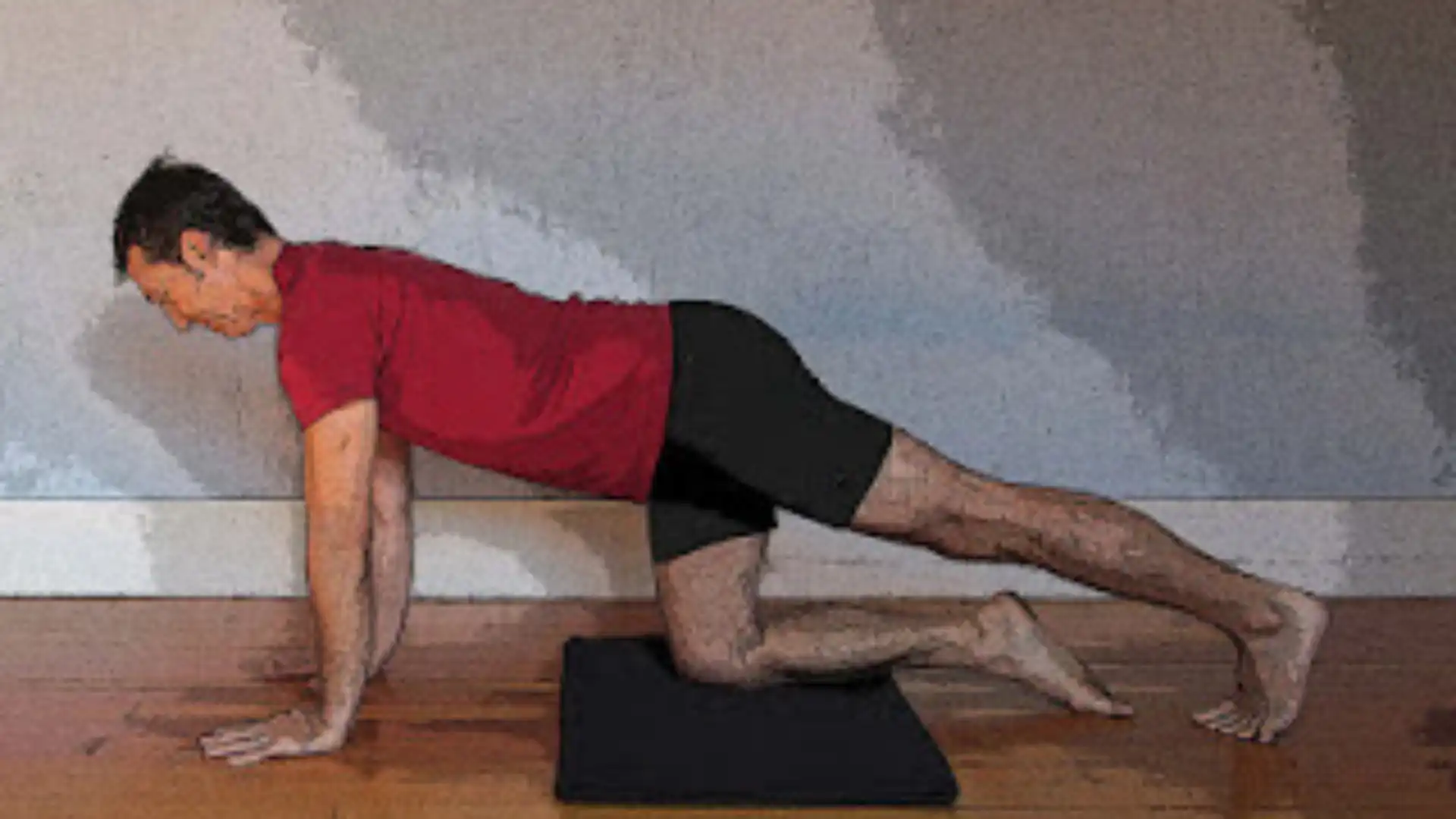
To protect your knees in this pose, it’s a good idea to come out of the pose carefully—especially if you end up sitting for long periods of time—because your knees have been deeply flexed in this position. So when you’re ready to come out, carefully shift forward onto your hands and knees and stretch one leg at a time back behind you to open up your knee joints. You may even wish to practice Uttanasana (Standing Forward Bend Pose) afterward to open your knee joints even more.
 Nina Zolotow, RYT 500, Editor-in-Chief of the Yoga for Healthy Aging blog, is both a yoga writer and a yoga teacher. She trained to be a yoga teacher at The Yoga Room in Berkeley, California, has studied yoga therapy with Shari Ser and Bonnie Maeda, and is especially influenced by the teachings of Donald Moyer. She also studied extensively with Rodney Yee, and is inspired by the teachings of Patricia Walden on yoga for emotional healing. Her special area of expertise is yoga for emotional well-being (including yoga for stress, insomnia, depression, and anxiety) and she teaches workshops and series classes on yoga for emotional well-being, stress management, better sleep, home practice, and cultivating equanimity. Nina is the co-author with Baxter Bell of Yoga for Healthy Aging: A Guide to Lifelong Well-Being and co-author with Rodney Yee of Yoga: The Poetry of the Body (with its companion 50 Card Practice Deck) and Moving Toward Balance. She is also the author of numerous articles on yoga and alternative medicine.
Nina Zolotow, RYT 500, Editor-in-Chief of the Yoga for Healthy Aging blog, is both a yoga writer and a yoga teacher. She trained to be a yoga teacher at The Yoga Room in Berkeley, California, has studied yoga therapy with Shari Ser and Bonnie Maeda, and is especially influenced by the teachings of Donald Moyer. She also studied extensively with Rodney Yee, and is inspired by the teachings of Patricia Walden on yoga for emotional healing. Her special area of expertise is yoga for emotional well-being (including yoga for stress, insomnia, depression, and anxiety) and she teaches workshops and series classes on yoga for emotional well-being, stress management, better sleep, home practice, and cultivating equanimity. Nina is the co-author with Baxter Bell of Yoga for Healthy Aging: A Guide to Lifelong Well-Being and co-author with Rodney Yee of Yoga: The Poetry of the Body (with its companion 50 Card Practice Deck) and Moving Toward Balance. She is also the author of numerous articles on yoga and alternative medicine.
 Baxter Bell, MD, C-IAYT, eRYT 500, is a yoga teacher and educator, physician and medical acupuncturist. These days he focuses on teaching yoga full-time, both to ordinary students of all ages and physical conditions and to the next generation of yoga teachers, to whom he teaches anatomy and yoga therapy along with his accessible, skillful style of yoga. Baxter brings a unique perspective to his teaching, combining his understanding of anatomy and medicine with his skill at instructing people from all walks of life and all levels of ability. Baxter is the co-founder and writer for the popular Yoga for Healthy Aging blog, where he shares his knowledge of medical conditions, anatomy, and yoga with practitioners and teachers across the world. In addition to being a frequent presenter at Yoga Journal Alive events and yoga conferences such as IAYT’s SYTAR, he is often quoted as an expert on yoga and health by major national news outlets such as The Washington Post and Wall Street Journal. To learn more, visit www.baxterbell.com, www.yogaforhealthyaging.blogspot.com, and his YouTube channel Baxter Bell Yoga. Baxter is the co-author with Nina Zolotow of Yoga for Healthy Aging: A Guide to Lifelong Well-Being.
Baxter Bell, MD, C-IAYT, eRYT 500, is a yoga teacher and educator, physician and medical acupuncturist. These days he focuses on teaching yoga full-time, both to ordinary students of all ages and physical conditions and to the next generation of yoga teachers, to whom he teaches anatomy and yoga therapy along with his accessible, skillful style of yoga. Baxter brings a unique perspective to his teaching, combining his understanding of anatomy and medicine with his skill at instructing people from all walks of life and all levels of ability. Baxter is the co-founder and writer for the popular Yoga for Healthy Aging blog, where he shares his knowledge of medical conditions, anatomy, and yoga with practitioners and teachers across the world. In addition to being a frequent presenter at Yoga Journal Alive events and yoga conferences such as IAYT’s SYTAR, he is often quoted as an expert on yoga and health by major national news outlets such as The Washington Post and Wall Street Journal. To learn more, visit www.baxterbell.com, www.yogaforhealthyaging.blogspot.com, and his YouTube channel Baxter Bell Yoga. Baxter is the co-author with Nina Zolotow of Yoga for Healthy Aging: A Guide to Lifelong Well-Being.
Also, read...
Teaching Svadhyaya: 3 Ways to Encourage Self-Study in Yoga
In Celebration of Gray-Haired Yoga – Busting the Myth of the Yoga Body
Related courses

Nina Zolotow, RYT 500, the author of the forthcoming book “Yoga for Times of Change” and the Editor-in-Chief of the Yoga for Healthy Aging blog, is both a yoga writer and a yoga teacher. She trained to be a yoga teacher at The Yoga Room in Berkeley, California, has studied yoga therapy with Shari Ser and Bonnie Maeda, and is especially influenced by the teachings of Donald Moyer. She also studied extensively with Rodney Yee and is inspired by the teachings of Patricia Walden on yoga for emotional healing. Her special area of expertise is yoga for emotional well-being (including yoga for stress, insomnia, depression, and anxiety). She teaches workshops and series classes on yoga for emotional well-being, stress management, better sleep, home practice, and cultivating equanimity.
Nina is the co-author with Baxter Bell of Yoga for Healthy Aging: A Guide to Lifelong Well-Being and co-author with Rodney Yee of Yoga: The Poetry of the Body (with its companion 50 Card Practice Deck) and Moving Toward Balance. She is also the author of numerous articles on yoga and alternative medicine.




